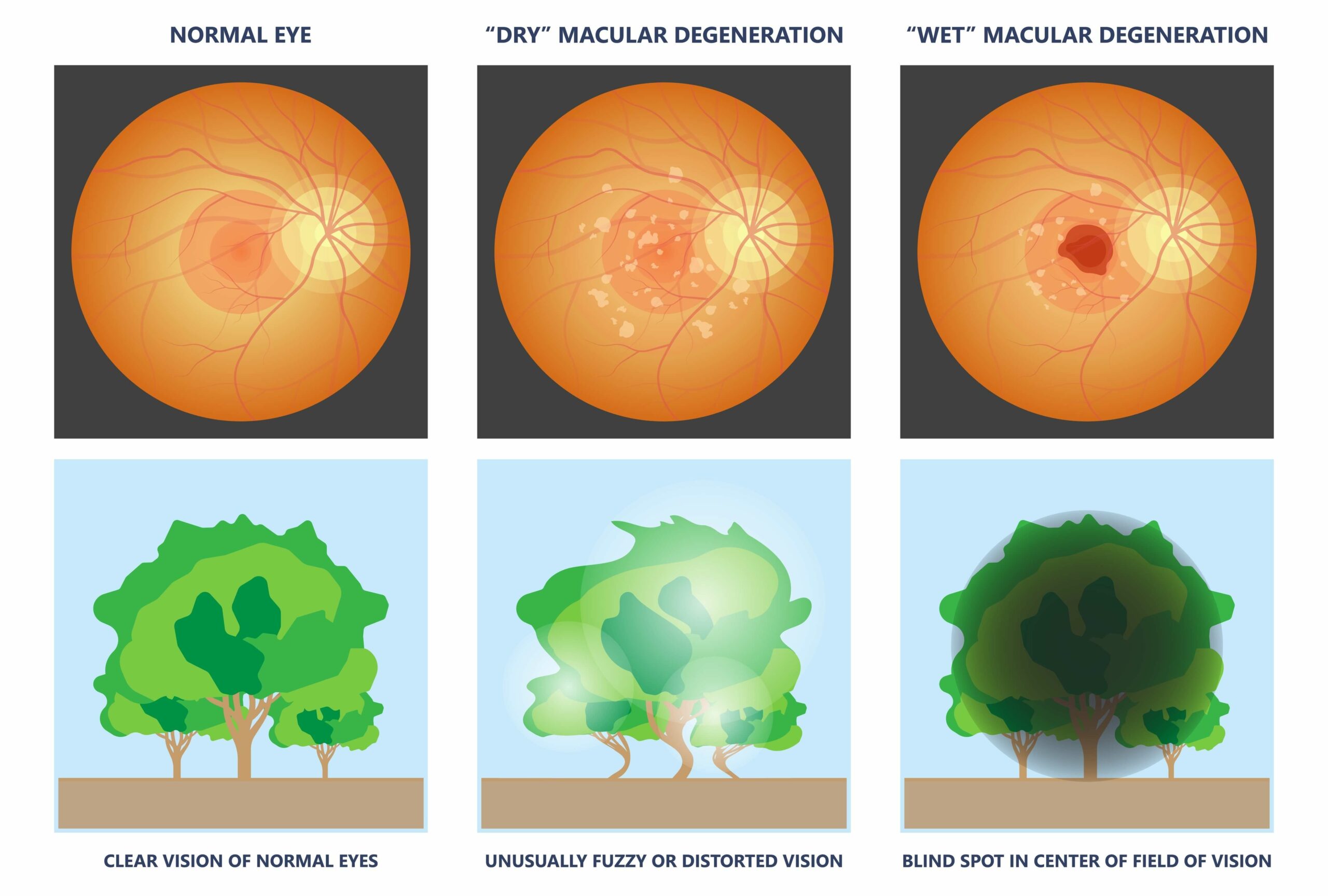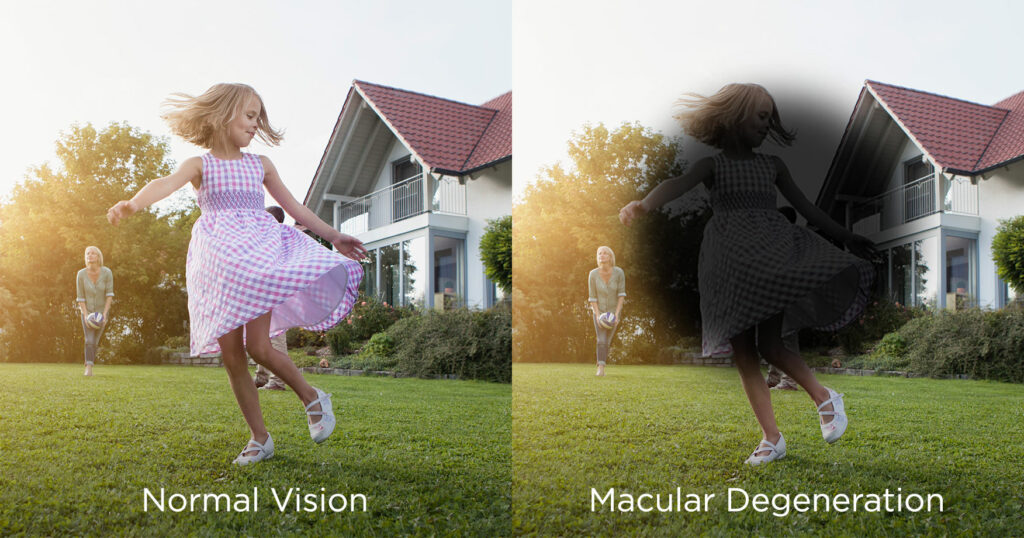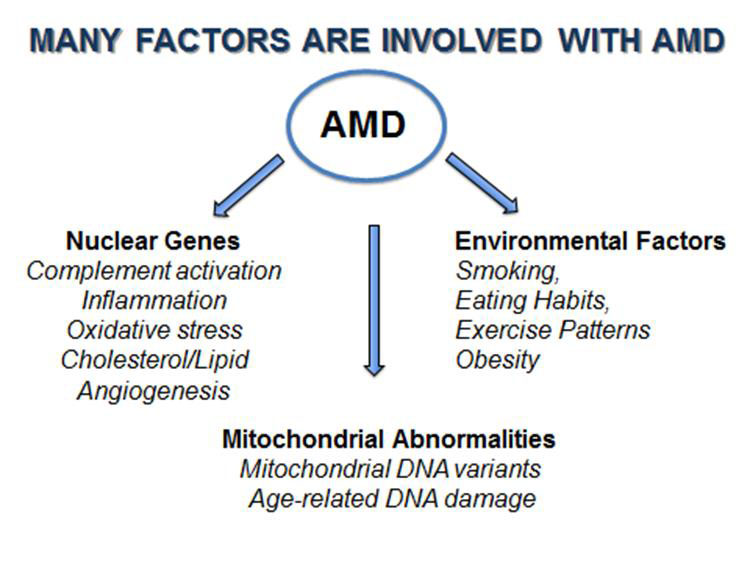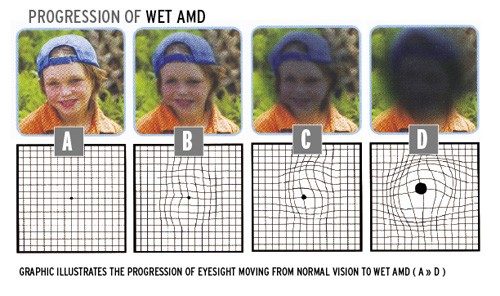Age-related macular degeneration (AMD) is a medical condition which usually affects older adults and results in a loss of vision in the center of the visual field (the macula) because of damage to the retina. It occurs in “dry” and “wet” forms. It is a major cause of blindness and visual impairment in older adults (>50 years). Macular degeneration can make it difficult or impossible to read or recognize faces, although enough peripheral vision remains to allow other activities of daily life.[1]
Age-related macular degeneration (AMD) is an eye disease that can blur your central vision. It happens when aging causes damage to the macula — the part of the eye that controls sharp, straight-ahead vision. The macula is part of the retina (the light-sensitive tissue at the back of the eye).[9]

Dry macular degeneration, also known as atrophic or non-neovascular age-related macular degeneration (AMD), is a common eye condition that primarily affects the macula, the central part of the retina responsible for sharp, central vision. In dry AMD, there is a gradual breakdown or atrophy of the light-sensitive cells in the macula, particularly the retinal pigment epithelium (RPE) cells. These cells are crucial for supporting the health and function of the photoreceptor cells, including cones, in the macula.
The condition progresses slowly over time and can lead to symptoms such as blurred central vision, distorted vision (metamorphopsia), and difficulty seeing in low light. Unlike wet AMD, which involves abnormal blood vessel growth, dry AMD typically does not involve leaking blood vessels.

There are two main types of dry macular degeneration:
- Early and Intermediate Dry Macular Degeneration: In the early stages, small yellow deposits known as drusen may form beneath the retina. Drusen are accumulations of waste materials that can interfere with the normal functioning of the macula. At this stage, individuals may not experience significant vision loss, and the condition may be detected during a routine eye exam.
- Advanced Dry Macular Degeneration (Geographic Atrophy): Over time, some individuals with dry AMD may progress to an advanced stage characterized by the development of geographic atrophy. Geographic atrophy involves the loss of RPE cells and photoreceptor cells in discrete patches, leading to the formation of atrophic or “geographic” areas in the macula. This can result in a more significant and irreversible loss of central vision.[8]

Macular Degeneration - Symptoms and Detection
Symptoms of Dry AMD include the presence of drusens that begin to enlarge. Another symptom is blurry areas in central vision. A symptom of Wet AMD is seeing straight lines as wavy ones.
A visual acuity test can help an eye care professional determine if any central vision is lost. An Amsler grid may also be used to detect AMD. In this test you cover one eye and stare at a black dot that has patterns of straight lines. If these lines appear wavy or are missing then AMD could be present.[2]

Prevention
There is growing evidence that by improving your diet, you may also improve the health of your eyes. Research has suggested an association between macular degeneration and a high saturated fat diet.
There is also evidence that eating fresh fruits and dark green, leafy vegetables – foods rich in vitamins C and E, selenium, and carotenoids (including beta-carotene, lutein and zeaxanthin) – may delay or reduce the severity of AMD.

How AMD can affect your sight?
AMD is progressive and it is also painless. While AMD may affect your central vision, most people still retain useful side (or peripheral) vision.
Key symptoms of AMD include:
- Distortion, where straight lines may appear wavy or bent. For example, lines of tiles in the bathroom appear wavy.
- Difficulty in reading or doing any other activity which requires fine vision.
- Difficulty in distinguishing faces.
- Dark patches or empty spaces, which appear in the centre of your vision.
- The need for increased illumination, sensitivity to glare, decreased night vision and poor colour sensitivity.[6]
:max_bytes(150000):strip_icc()/VWH_Illustration_Home-Remedies-and-Lifestyle-Changes-for-AMD_Illustrator_Michela-Buttignol_Final-afd2b2bd5d6743e5a473d4846f6573cd.jpg)
Foods to Enjoy eResearch by Navid Ajamin -- spring 2012
Eat the freshest and brightest fruits and vegetables. Pick the most colorful vegetables and fruits you can find - red, dark green, orange, or yellow. These foods play a key role in keeping your eyes healthy:
Carrots Corn Kiwi Pumpkin Yellow squash Zucchini squash Red grapes Green peas Cucumber Butternut squash Green bell pepper Celery Cantaloupe Sweet potatoes Dried apricots Tomato and tomato products Dark green leafy vegetables Spinach Kale Turnips Collard greens ...
Fish
Eating fatty fish such as salmon, tuna or mackerel two to three times per week can slow the progression of age-related macular degeneration (AMD) according to a study published in the British Journal of Ophthalmology.
This research further confirms earlier studies that suggested eating fish can help reduce the risk of getting AMD and demonstrates that some of those already affected by the disease can benefit as well.
Nuts
Nuts not only contain Omega-3 fatty acids, but also copper which can play a role in preventing age-related eye diseases. Even just a handful of nuts at two or three times a week can reduce your risk of AMD.
Foods to Avoid
A high-fat, high-cholesterol diet can lead to fatty plaque deposits in the macular vessels, which can hamper blood flow and increase the risk of AMD. A diet low in fat promotes good eye health. Skip foods and processed baked goods with high-fat content. In addition recent research has indicated that those consuming red meat (10 times a week or more) were at 47% higher risk for macular degeneration.
Vitamins and Supplements
The National Eye Institute’s Age-Related Eye Disease Study (AREDS) found that taking a specific high-dose formulation of antioxidants and zinc significantly reduces the risk of advanced AMD and its associated vision loss. Slowing AMD’s progression from the intermediate stage to the advanced stage will save the vision of many people.
People who should consider taking the combination of antioxidants plus zinc include those who are at high risk for developing advanced AMD. These people are defined as having either:
Intermediate AMD in one or both eyes. Intermediate AMD is defined as the presence of either many medium-sized drusen or one or more large drusen.
Advanced AMD in one eye, but not the other eye. Advanced AMD is defined as either a breakdown of light-sensitive cells and supporting tissue in the central retinal area (advanced dry form), or the development of abnormal and fragile blood vessels under the retina (wet form) that can leak fluid or bleed. Either of these forms of advanced AMD can cause vision loss. Ask you doctor if taking this special formulation is right for you and where you can obtain the specific formula in your country.[3]
Grapes May Help Prevent AMD
Can eating grapes slow or help prevent the onset of age-related macular degeneration (AMD), a debilitating condition affecting millions of elderly people worldwide? Results from a new study published in Free Radical Biology and Medicine suggest this might be the case. The antioxidant actions of grapes are believed to be responsible for these protective effects.[4]
Home Remedies and Lifestyle Changes [7]
The risk factors for macular degeneration are similar to those of heart disease and stroke. For this reason, lifestyle changes that benefit your heart may also benefit your vision. Lifestyle modifications to consider include:
- Quitting smoking
- Making dietary changes, such as limiting foods high in saturated fats (meat, butter, and cheese) and eating a heart-healthy diet full of whole grains, fruits, and vegetables
- Maintaining weight, since obesity is also a risk factor of dry AMD
- Managing blood pressure
- Using sun protection, such as wearing wide-brimmed hats and sunglasses
- Getting regular exercise (at least 30 minutes of physical activity every day)
As central vision declines in late-stage dry AMD, you can use low-vision tools, such as magnifying tools and handheld computers, to help with daily activities. Low-vision techniques, like using high-lumen light sources, reducing glare, and increasing contrast, can also help compensate for central vision loss.
Discussion. This systematic review and meta-analysis has shown that 8·7% of the worldwide population has age-related macular degeneration, and the projected number of people with the disease is around 196 million in 2020, increasing to 288 million in 2040.[5]
Reference:
- en.wikipedia.org/wiki/Macular_degeneration
- eyehealthweb.com/diseases/macular-degeneration
- amdalliance.org/information_prevention.html
- careyeasy.com/eye-care-news/grapes-may-help-prevent-amd
- sciencedirect.com/science/article/pii/S2214109X13701451#
- vi.ie/supporting-you/everyday-living/eye-conditions/age-related-macular-degeneration-amd
- verywellhealth.com/how-dry-amd-is-treated-5192080
- rvaf.com/diseases/amddry
- nei.nih.gov/learn-about-eye-health/eye-conditions-and-diseases/age-related-macular-degeneration
See also: How Age-Related Macular Degeneration Is Treated
 وبلاگ تخصصی عینک شامل مجموعه مطالب پزشکی است که اطلاعات مفیدی در رابطه با عینک , چشم، لنز، سلامتی چشم و راه های پیشگیری از بیماریهای چشمی، کنترل و درمان آن را در اختیار شما کاربر محترم می گزارد.
وبلاگ تخصصی عینک شامل مجموعه مطالب پزشکی است که اطلاعات مفیدی در رابطه با عینک , چشم، لنز، سلامتی چشم و راه های پیشگیری از بیماریهای چشمی، کنترل و درمان آن را در اختیار شما کاربر محترم می گزارد.